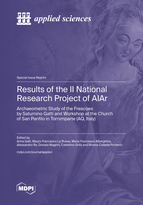Results of the II National Research Project of AIAr: Archaeometric Study of the Frescoes by Saturnino Gatti and Workshop at the Church of San Panfilo in Tornimparte (AQ, Italy)
A special issue of Applied Sciences (ISSN 2076-3417). This special issue belongs to the section "Earth Sciences".
Deadline for manuscript submissions: closed (30 April 2023) | Viewed by 15141
Special Issue Editors
Interests: physics applied to cultural heritage; archaeometry; TL dating; OSL dating X-ray fluorescence; ancient material characterization
Special Issues, Collections and Topics in MDPI journals
Interests: cultural heritage; characterization of stone building materials and their decay; experimentation of innovative protective products; archaeometric study of chronologically different ceramic remains in subaerial and underwater environments
Special Issues, Collections and Topics in MDPI journals
Interests: non-destructive spectroscopy investigations for materials characterization; radiography imaging and multispectral investigation for studying artistic techniques and conservation state; analyses and monitoring to evaluate degradation phenomena and to assess effectiveness of conservative treatment
Interests: ion beam analysis techniques; digital X-ray imaging; provenance study of lapis lazuli
Interests: development and application of non-invasive techniques to identify and characterize painting materials and their state of conservation (UV-VIS-NIR spectroscopy, XRF, TR-FTIR); characterization of pigments and binding media in polychrome art works by means of micro-invasive spectroscopic techniques and analysis of painting polished cross-sections (FT-IR, SEM-EDS, XRD, OM, PLM); application of imaging techniques (UVf, IR, IRfc, VIL) to localize materials and study the painting technique; study of ancient residual polychromy on marble art facts; analysis of provenancing for ancient marble By non –invasive techniques; environmental monitoring
Interests: applied petrography to cultural heritage and archaeological science; archaeological and traditional ceramics; stone materials of the historical building / historical building stones; petrography and petrology of igneous rocks / igneous petrology
Interests: archaeometry; vibrational spectroscopy; instrument development; SERS nanomaterials; neutron studies
Special Issues, Collections and Topics in MDPI journals
Special Issue Information
Dear Colleagues,
The archaeometric study of the frescoes by the painter Saturnino Gatti (1463-1518) in the apse of the Church of San Panfilo in Villagrande di Tornimparte (L'Aquila) is the subject of the II National Research Project conducted by members of the Italian Association of Archaeometry (AIAr). The research activities were carried out as part of a scientific agreement of the AIAr, signed in 2020 by the Abruzzo Regional Secretariat of the Ministry for Culture and Superintendence of Archaeology, Fine Arts and Landscape for the provinces of L'Aquila and Teramo. Several in situ non-destructive investigations and laboratory analyses on micro-fragments sampled from the different levels of pictorial cycle were carried out thanks to the co-working of 21 Research Groups with more than 60 AIAr researchers involved in the different stages of scientific studies of pictorial materials and of the environmental conditions in which the frescoes are now preserved. The present Special Issue represents an important opportunity to illustrate for the first time the results of the pre-restoration diagnostic study. The macro-objectives followed by the working groups coordinated by the Governing Council AIAr members were:
- To document the state of conservation of the architectural building and the painted surfaces;
- To analyse microclimate and inertia level of the church with respect to outdoor conditions;
- To understand the degradation phenomena of the pictorial surfaces and the mural structures;
- To identify and map non-original materials overlapped to pictorial surfaces during previous restoration works;
- To characterize the original materials of the frescoes and “a secco” mural paintings;
- To identify the artistic technique and typical features of Saturnino Gatti and the others painters who worked at the frescoes in San Panfilo.
Dr. Anna Galli
Dr. Mauro Francesco La Russa
Dr. Maria Francesca Alberghina
Dr. Alessandro Re
Dr. Donata Magrini
Dr. Celestino Grifa
Dr. Rosina Celeste Ponterio
Guest Editors
Manuscript Submission Information
Manuscripts should be submitted online at www.mdpi.com by registering and logging in to this website. Once you are registered, click here to go to the submission form. Manuscripts can be submitted until the deadline. All submissions that pass pre-check are peer-reviewed. Accepted papers will be published continuously in the journal (as soon as accepted) and will be listed together on the special issue website. Research articles, review articles as well as short communications are invited. For planned papers, a title and short abstract (about 100 words) can be sent to the Editorial Office for announcement on this website.
Submitted manuscripts should not have been published previously, nor be under consideration for publication elsewhere (except conference proceedings papers). All manuscripts are thoroughly refereed through a single-blind peer-review process. A guide for authors and other relevant information for submission of manuscripts is available on the Instructions for Authors page. Applied Sciences is an international peer-reviewed open access semimonthly journal published by MDPI.
Please visit the Instructions for Authors page before submitting a manuscript. The Article Processing Charge (APC) for publication in this open access journal is 2400 CHF (Swiss Francs). Submitted papers should be well formatted and use good English. Authors may use MDPI's English editing service prior to publication or during author revisions.
Keywords
- frescoes
- microclimate analysis
- photogrammetric 3D restitution
- non-invasive analyses
- minero-petrographic characterization












